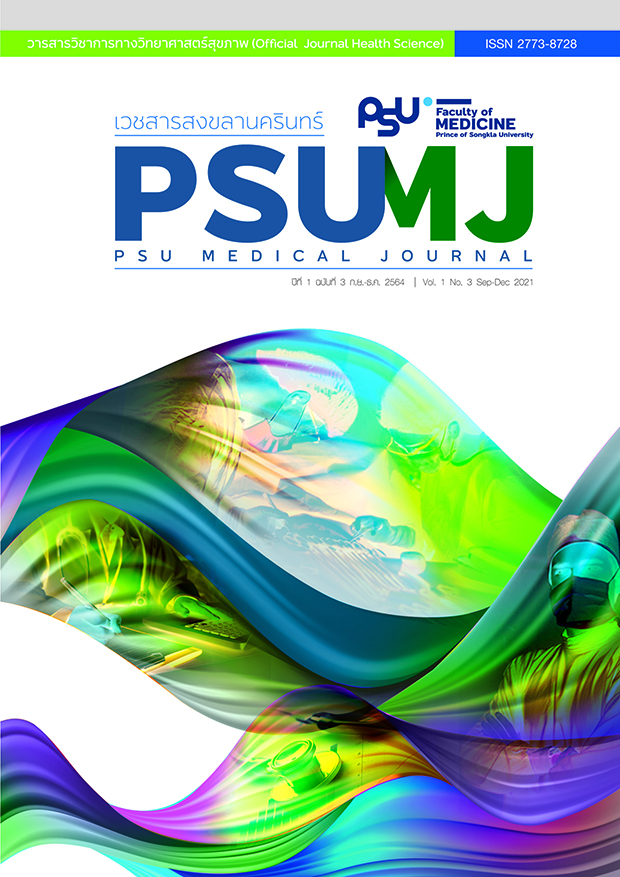Effect of Installation of Alcohol Gel Dispensers and Behavioral Nudges on Behavioral Drivers for Hand Hygiene: A Quasi-Experimental Study at a Tertiary Hospital during the COVID-19 Pandemic
Dispensers-Nudges and COVID-19 Hand Hygiene Beliefs
DOI:
https://doi.org/10.31584/psumj.2021245328Keywords:
COVID-19, hand hygiene, health beliefs, nudges, social normsAbstract
Objective: To compare the level of hand hygiene behavioral drivers before and after installation of alcohol gel dispensers and behavioral nudges among outpatients and visitors at a tertiary hospital in Thailand during the coronavirus disease 2019 (COVID-19) pandemic.
Material and Methods: A quasi-experimental study was conducted among outpatients and visitors in June 2020. We installed 12 alcohol gel dispensers with signs serving as behavioral nudges at a tertiary hospital in the Internal Medicine Outpatient Department (OPD), Surgery OPD, and the Pharmacy. We trained enumerators to interview outpatients and visitors regarding their behavioral drivers (beliefs about COVID-19 and hand hygiene based on the health belief model, plus handwashing social norms). We analyzed data using descriptive statistics.
Results: Enumerators recruited 206 participants in the pre-intervention phase (refusal rate = 37.6%) and 219 participants in the post-intervention phase (refusal rate = 32.2%). There were significant differences between the pre-intervention and post-intervention phases with regard to self-efficacy for hand hygiene (92.0% vs. 100%, respectively), perceived lack of barriers to hand hygiene with alcohol (93.2% vs. 98.2%, respectively), and the proportion of participants who reported that hand hygiene had become a habit (7.5 vs. 18.8%, respectively). Reports of other domains of health beliefs (perceived severity of COVID-19, perceived benefits of handwashing) were homogeneous in both periods.
Conclusion: We found differences in perceived lack of barriers and reported habit of hand hygiene but while self-efficacy was homogeneous in both periods. Issues regarding selection bias, construct validity, and generalizability may limit the usefulness of the study data. Caveats should be considered in the interpretation of the study findings.
References
Biswas D, Ahmed M, Roguski K, Ghosh PK, Parveen S, Nizame FA, et al. Effectiveness of a Behavior Change Intervention with Hand Sanitizer Use and Respiratory Hygiene in Reducing Laboratory-Confirmed Influenza among School children in Bangladesh: A Cluster Randomized Controlled Trial. Am J Trop Med Hyg 2019;101:1446–55.
Rosenbaum J. Incorporating nudges into COVID-19 Com munication and Prevention Strategies [monograph on the Internet]. Wahington, D.C.: Global Hand Washing Partnership; 2020 [cited 2020 Aug 19]. Available from: https://globalhand- washing.org/incorporating-nudges-into-covid-19-communi cation-and-prevention-strategies/
UNICEF. COVID-19 Emergency Preparedness and Response - WASH and Infection Prevention and Control in Health Care Facilities: Guidance Note [monograph on the Internet]. New York: UNICEF; 2020 [cited 2020 Aug 19] Available from: https://www.unicef.org/media/66386/file/WASH-COVID- 19-infection-prevention-and-control-in-health-care-facili- ties-2020.pdf
Freeman MC, Stocks ME, Cumming O, Jeandron A, Higgins JPT, Wolf J, et al. Systematic review: Hygiene and health: systematic review of handwashing practices worldwide and update of health effects. Trop Med Int Health 2014;19:906–16.
iNudgeyou. Nudging Hospital Visitors’ Hand Hygiene Compliance [monograph on the Internet]. Copenhagen, Denmark: The Applied Behavioral Science Group; 2016 [cited 2020 Aug 19]. Available from: https://inudgeyou.com/en/nudging- hospital-visitors-hand-hygiene-compliance/
Connor M. Health behaviors. In: Smelser NJ, Baltes PB, editors. International Encyclopedia of the Social & Behavioral Sciences. Oxford, United Kingdom: Pergamon; 2001;p.6506–12.
Bicchieri C. Norms in the wild: how to diagnose, measure and change social norms/Christina Bicchieri. New York: Oxford University Press; 2017;p.239.
Dreibelbis R, Kroeger A, Hossain K, Venkatesh M, Ram PK. Behavior Change without Behavior Change Communication: Nudging Handwashing among Primary School Students in Bangladesh. Int J Environ Res Public Health 2016;14:1–7.
Zuko D. How UX designers can encourage social distancing during the COVID-19 pademic [city not specified]: UX collective; 2020 [cited 2020 Aug 19] Available from: https:// uxdesign.cc/how-ux-designers-can-encouage-social- distancing-during-the-covid-19-pandemice7d2ac42e3b5?gi= f1d97b723717
Rosenstock IM, Strecher VJ, Becker MH. The Health Belief Model and HIV Risk Behavior Change. In: DiClemente RJ, Peterson JL, editors. Preventing AIDS AIDS Prevention and Mental Health. Boston: Springer; 1994.
Harvard Humanitarian Initiative. About KoBoToolbox [homepage on the Internet]. Cambridge, MA: KoBoToolbox; 2020. [cited 20 Aug 19] Available from: https://www.kobotoolbox.org/
Chongsuvivatwong V. Analysis of epidemiological data using R and Epicalc. Songkhla: Epidemiology Unit, Prince of Songkla University; 2015;p.314.
Rajaraman D, Varadharajan KS, Greenland K, Curtis V, Kumar R, Schmidt W-P, et al. Implementing effective hygiene promotion: lessons from the process evaluation of an in tervention to promote handwashing with soap in rural India. BMC Public Health 2014;14:1179.
Raihan MJ, Farzana FD, Sultana S, Haque MA, Rahman AS, Waid JL, et al. Examining the relationship between socioeconomic status, WASH practices and wasting. PLOS ONE 2017;9:e0172134.
Schmidt W-P, Aunger R, Coombes Y, Maina PM, Matiko CN, Biran A, et al. Determinants of handwashing practices in Kenya: the role of media exposure, poverty and infrastructure. Trop Med Int Health 2009;14:1534–41.
Latkin CA, Mai NVT, Ha TV, Sripaipan T, Zelaya C, Le Minh N, et al. Social desirability response bias and other factors that may influence self-reports of substance use and HIV risk behaviors: a qualitative study of drug users in Vietnam. AIDS Educ Prev 2016;28:417–25.
Hinz A, Michalski D, Schwarz R, Herzberg PY. The acquiescence effect in responding to a questionnaire. Psychosoc Med 2007;20:Doc07.
Glanz K, Bishop DB. The role of behavioral science theory in development and implementation of public health interventions. Annu Rev Public Health 2010;31:399–418.
King D, Vlaev I, Everett-Thomas R, Fitzpatrick M, Darzi A, Birnbach DJ. “Priming” hand hygiene compliance in clinicalenvironments. Health Psychol 2016;35:96–101.








